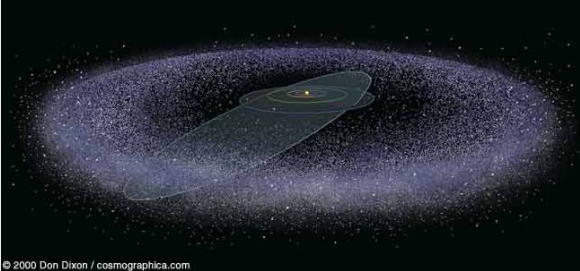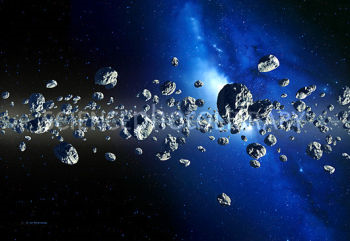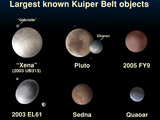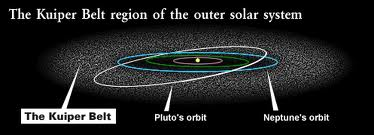In the beginning of 1992, scientists noticed a large concentration of small objects located beyond Neptune and orbiting the sun. Keen observations revealed that these objects were clustered together and occupied a disc-shaped region around the sun. This region is the Kuiper Belt.
A Photo of the Kuiper Belt Image Source
Why Is the Kuiper Belt of Interest to Astronomers?
Scientists are fascinated with the Kuiper Belt because they believe that the objects occupying this belt are made up of remains of materials from the early solar system. Study of these objects could provide insights into the beginning of the solar system. Astronomers also believe that short-period comets visible on earth originate from the Kuiper Belt.
What Is the Difference between an Asteroid Belt and a Kuiper Belt?
Just like an asteroid belt, the Kuiper Belt has an elliptical shape. It is similar to the asteroid belt that exists between Mars and Jupiter. However, an asteroid belt is made up of mainly metal and rocky objects while the Kuiper belt is composed of ice, ammonia and methane like comets and other objects.
What Are The Objects Found In The Kuiper Belt?
Kuiper Belt Objects Image Source
Astronomers believe that there are more than 70,000 objects of different sizes occupying this belt. These are known as the Kuiper Belt Objects (KBOs). They are also known as Transneptunian objects because they are located beyond Neptune.
This region is believed to be home to short-lived comets. Images taken by the Hubble Space Telescope show about 30 objects that are similar in size to the comets that we see from Earth.
There are also large and spherical bodies classified as dwarf planets because they are too large to be classified as asteroids and too small to be classified as true planets. These objects have a strange orbit around the sun and haven’t cleared out the space around them like the 8 true planets. The most popular and largest objects found in this region include Quaoar, Pluto, Eris, Triton, Makemake, Haumea and Charon Pluto’s moon.
Scientists believe the Kuiper Belt Objects also include hundreds of thousands of icy objects orbiting the sun.
Largest Kuiper Belt Objects Image Source: NASA
Has There Been A Mission or Visit To The Kuiper Belt?
As of now, no spacecraft has visited the Kuiper Belt. NASA’S New Horizons is on its way to Pluto and is set to arrive in 2015. After studying Pluto, it is expected to continue with its journey and explore this region to learn more about its objects and the remains from the birth of the solar system. The New Horizons Mission is expected to study some of the popular dwarf planets and other KBO objects.
Why Is It Called The Kuiper Belt?
The Kuiper Belt was named after Gerald Kuiper, an astronomer who predicted the existence of a belt composed of icy objects located beyond Neptune in 1951. He also predicted that this area was home to periodic comets that appear as brilliant objects across the inner solar system.
Gerald Kuiper Predicted the Existence of the Kuiper Belt Image Source
How Big Is The Kuiper Belt?
The Kuiper Belt is an extensive elliptical region that extends 30-50 times Earth’s distance from the sun, which translates to 2.5-4.5 billion miles or 4.5-7.4 billion kilometers from the sun. The Kuiper Belt objects span 62 miles or 100km in diameter.
Where In Space Is The Kuiper Belt Located?
The Kuiper Belt extends from near the orbit of Neptune and goes beyond the orbit of Pluto. It is an elliptical region with some areas being 30 astronomical units from the sun and others 50 astronomical units from the sun.
Kuiper Belt Location Image Source
Is It Possible To See The Kuiper Belt Objects?
The Kuiper Belt Objects are so small and so far away that it is hard to see them with the naked eye or even a typical telescope. NASA’S space-based telescope Spitzer has used infrared measurements to estimate the sizes of the larger objects found here.
How Was The Kuiper Belt Formed?
After the formation of the solar system, most of the gas, dust and rock remnants came together and formed the sun and the planets. The planet’s gravitational force then forced the remaining remnants of materials into the sun or further out of the solar system.
However, bodies and materials in the distant space were not affected by the gravitational force of the planets. They kept their position, characteristics and orbits around the sun. These objects occupy the Kuiper Belt.
Scientists believe that the KBOs were formed further from the sun than the Oort Cloud Objects, which reside further in the solar system because they formed closer to the sun and were scattered to the distant solar system by gravitational forces of the planets.





